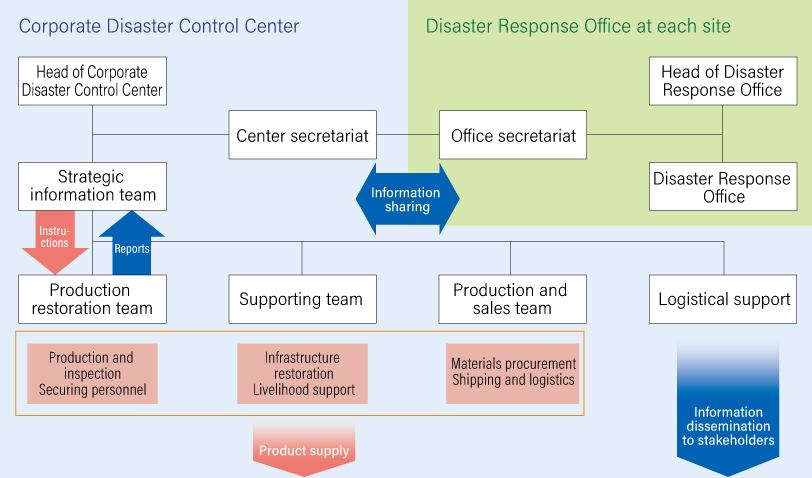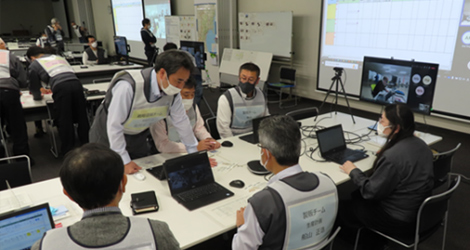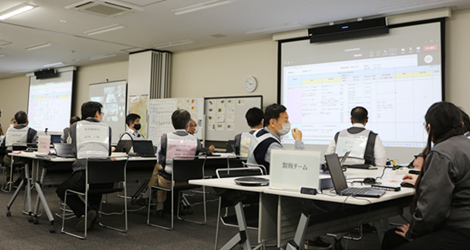- Home
- Sustainability
- Risk Management
Governance
Risk Management
The Dexerials Group defines risk as a factor that impede the achievement of business goals or causes the suspension of business continuity. To ensure operational safety and business continuity, and to fulfill our responsibility to supply customers, the entire Group comprehensively takes risk mitigation in anticipation of risks to our Company's management and society.
Risk Management Structure
In October 2021, we newly established a risk management section, recognizing the need for a higher level of risk management to strengthen our corporate resilience to respond to the emerging risks in the face of increasing social uncertainty, especially in the wake of the recent COVID-19 pandemic and the ever-increasing prevalence of cyberattacks. Since fiscal 2022, we have been working to restructure our risk management systems and methods and strengthen our risk management activities.
In accordance with risk management regulations, the Dexerials Group has established a Risk Management Committee, with the Representative Director appointed as the Chief Risk Management Officer and an Executive Officer appointed as the Risk Manager. The Risk Management Committee establishes risk subcommittees for each functional specialized domain, discusses high importance risks, and regularly reports on the status of risk responses to the Board of Executive Officers. These risk responses are evaluated, revised, and then reported to the Board of Directors.
Risk Management Process
Since the internal and external environments change day by day, the Risk Management Committee plays a central role in risk management through the following process so that measures can be taken at the appropriate time.
- 1:Comprehensively Identify Risks and Analyze them based on specific event assumptions and actualized scenarios
- 2:Conduct Risk Evaluation by scoring risks qualitatively and quantitatively
- 3:Prioritize responses to risks with high scores by selecting them as “priority risks to address” that have a significant impact on the Company's management and business operations.
- 4:Formulate and execute Risk Treatment
- 5:The Board of Executive Officers provides details on its monthly monitoring activities and gives instructions to ensure that measures are taken at the appropriate time
- 6:Continuous improvement through semi-annual reviews
➔ In the next fiscal year, “priority risks to address” will be reviewed at the time of risk identification and further measures will be discussed
Risk Management Structure and Process
BCP (Business Continuity Planning) Activities
Earthquakes, typhoons, and other natural disasters caused by climate change may cause serious damage to the personnel, facilities, and lifeline utilities required for operation.
The Group systematically implements employee training, along with safety measures and improvements to its facilities and operations, to prevent or minimize damage from disasters and accidents that potentially could have a serious impact on business.
We also develop a BCP, conduct drills, and review the plan as necessary to ensure that our business can continue to operate in the event of damage from a disaster or accident.
In fiscal 2022, we revised the operation of the safety confirmation system and established new detailed regulations for emergency communication methods. This enabled us to quickly confirm the safety of employees in the event of a disaster.
We are strengthening the BCP promotion framework to implement the BCP without delay, minimize damage, and continue or restore our business, after first ensuring the safety of the lives of employees and other people involved in the operations.
In addition, we are comprehensively strengthening our BCP by clarifying the BCP structure and the target level of response capabilities to be achieved, introducing DX, developing a monitoring system to determine whether or not there is any impact in the event of an emergency, and conducting cross-company training.
Organizational Structure and Functional Roles within BCP
In fiscal 2021, to control information and instructions in the event of a disaster or emergency, we reorganized the structure of the Corporate Disaster Control Center, which oversees the entire Group, and the Disaster Response Office, which is responsible for initial response and recovery at each site and Group companies.
The Corporate Disaster Control Center has a well-organized function-based team structure. Under the Head of Corporate Disaster Control Center, who is in charge of overall supervision, it consists of a strategic information team consisting of a commander and team leaders, and functional teams. The Disaster Response Office has improved mobility by reorganizing the structure based on the roles required for it, under the supervision of the Head of Disaster Response Office, who is responsible for each business site.
In an emergency, we set up the Corporate Disaster Control Center and Disaster Response Office upon an alarm signal from the safety confirmation system and quickly summon the members.
 BCP structure
BCP structureStrengthening BCP, Education, and Training
With the aim of strengthening BCP in the event of an emergency, we are working to improve administrative control and coordination among sites and improve mobility by collecting and sharing information through BCP training, introducing various tools such as response and recovery planning, establishing a remote environment, and introducing a remote tool.
Specifically, in fiscal 2022, we conducted BCP training in anticipation of a disaster at one of our subsidiaries, and we are strengthening BCP in cooperation with them.
In March 2023, we installed solar-powered electrical outlets for use in disasters in the Reception Hall, a newly constructed facility to communicate with customers, shareholders, local communities, employees and other stakeholders. We prepared for the initial response and a secure means of communications in the event of a disaster.
 BCP training at Tochigi
BCP training at Tochigi BCP training at Dexerials Photonics Solutions Corporation
BCP training at Dexerials Photonics Solutions Corporation- Remote BCP training
In addition to gathering at the Corporate Disaster Control Center, we conduct BCP training assuming remote responses, such as when damage occurs across several location sites or when the team members are at home.
Through the training, including information organization and sharing, response status, and discussions, we improved the tools we used in BCP and developed other tools and environments necessary for remote responses. Tools and equipment for BCP are stored at the Corporate Disaster Control Center and the Disaster Response Offices of the sites and Group companies to ensure prompt response in an emergency.
In anticipation of voice and data communications disruptions, satellite phones and MCA (Multi-Channel Access) radios are installed at each site. We conduct regular call drills and equipment inspections, preparing for unforeseen circumstances.


- Emergency drills
In a disaster or emergency, it is necessary to respond quickly and appropriately to prevent or mitigate human casualties and secondary disasters. We conduct drills for all employees every year, even amid the COVID-19 pandemic, to improve our disaster prevention system and enhance our response capabilities. Those drills include fire extinguishing and evacuation drills, comprehensive disaster drills for earthquake simulation, and safety confirmation drills using the safety confirmation system. Stockpiles and disaster supplies are stored and managed at each site in anticipation of people having difficulty returning home in a disaster. The storage information is centrally managed and shared to enable mutual support between sites. A system is in place to quickly dispatch emergency instructions and communications to employees, such as to stay at home or come to work, through the safety confirmation system.
 An emergency drill
An emergency drill

